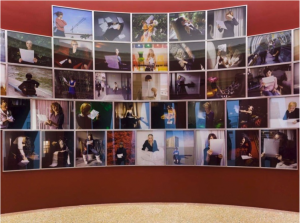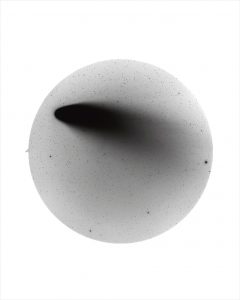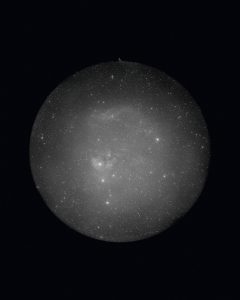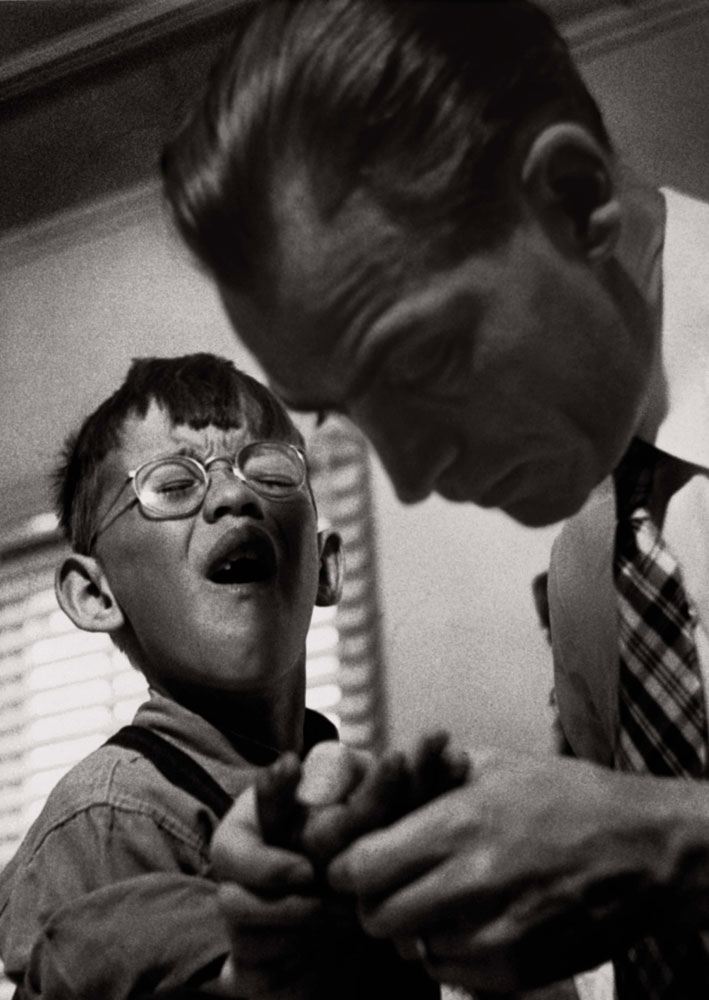Examples of relay in contemporary photographic practice include Sophie Calle’s Take Care of Yourself and Sophy Rickett’s Objects in the Field (see interview in the Appendix to this course guide) where clashes of understanding or interpretation work together to create a perhaps incomplete but nonetheless enriching dialogue between artist and viewer.
Look these pieces up online. Investigate the rationale behind the pieces and see if you can find any critical responses to them. Write down your own responses in your learning log.
How do these two pieces of work reflect postmodern approaches to narrative?
Some definitions:
Anchorage: words that help limit the meaning of an image or ‘anchor’ its meaning.
Relay: alters or advances the. meaning. – Text that advances the image by supplying meanings not found in the image itself. example: film dialogue, ‘zine captions, visual pun. Image and text brings their own new bit of information to the overall message.
Postmodernism:
Postmodernism is a broad term used to describe movements in a wide range of disciplines, including art, philosophy, critical theory, and music. Many view it as a response to the preceding modernist movement, but where modernism simply reacts against classical concepts, particularly in the arts and literature, things that are postmodern take this reaction to its extreme conclusion. Indeed, some see it not as a separate movement, but simply as a continuation of the modernist struggle.|(https://www.infobloom.com/what-is-postmodernism.htm) (accessed -29/12/20210)
Examples:https://www.theartstory.org/definition/postmodernism/artworks/ (accessed -29/12/20210)
https://artincontext.org/postmodern-art/ (accessed -29/12/20210)
Postmodernism is best understood by defining the modernist ethos it replaced – that of the avant-garde who were active from 1860s to the 1950s. The various artists in the modern period were driven by a radical and forward thinking approach, ideas of technological positivity, and grand narratives of Western domination and progress. The arrival of Neo-Dada and Pop art in post-war America marked the beginning of a reaction against this mindset that came to be known as postmodernism. The reaction took on multiple artistic forms for the next four decades, including Conceptual art, Minimalism, Video art, Performance art, Institutional Critique, and Identity Politics. These movements are diverse and disparate but connected by certain characteristics: ironical and playful treatment of a fragmented subject, the breakdown of high and low culture hierarchies, undermining of concepts of authenticity and originality, and an emphasis on image and spectacle. Beyond these larger movements, many artists and less pronounced tendencies continue in the postmodern vein to this day.
Postmodernism overturned the idea that there was one inherent meaning to a work of art or that this meaning was determined by the artist at the time of creation. Instead, the viewer became an important determiner of meaning, even allowed by some artists to participate in the work as in the case of some performance pieces. Other artists went further by creating works that required viewer intervention to create and/or complete the work https://www.theartstory.org/definition/postmodernism/ (accessed 29/12/20210)
Sophie Calle’s Take Care of Yourself
This piece of work is a response to the break up of a relationship and specifically an email Sophie Calle got from her ex lover. She didn’t fully understand the email and so asked 107 women from different backgrounds to interpret it according to their understanding and expertise. As she explains:
“I received an email telling me it was over.
I didn’t know how to respond.
It was almost as if it hadn’t been meant for me.
It ended with the words, “Take care of yourself.”
And so I did.
I asked 107 women (including two made from wood and one with feathers),
chosen for their profession or skills, to interpret this letter.
To analyse it, comment on it, dance it, sing it.
Dissect it. Exhaust it. Understand it for me.
Answer for me.
It was a way of taking the time to break up.
A way of taking care of myself.“
The result is 107 interpretations communicated through different media and artefacts.There is no liner story here but each interpretation adds to the narrative and relays the possible meanings. In an interview with Brian Dillion (https://artreview.com/history-lessons-7-april-2020-brian-dillon-sophie-calle-interview/ accessed 31/12/2021) she comments,
‘The email itself will appear in full, also translated into Morse code, Braille, binary and barcode. There will be the marked-up text as corrected by a proofreader, the email rendered in cipher by an agent of the secret service, a report on its legal standing by a contract lawyer, the reaction of a nine-year-old child, an SMS translation. In the films, the dancers dance, the singers sing and the clown hides and sniggers at the intimate bits. Jeanne Moreau’s film is among the longest: she pauses to comment wearily on each of the letter’s manifest effronteries. In the last of the films, a parrot that has been taught the text of the letter rips a copy of it to pieces with its beak, addresses the camera and speaks, I have never lied to you. I will always love you.

Sophie Calle, Take Care of Yourself, 2007 (installation view of French Pavilion at 52nd Venice Biennale). Courtesy Perrotin
Why this interest, the journalist wants to know, in such ephemeral but formalised texts? Why my taste for such flat modes of writing: the diary, the questionnaire, the list, the report? Why this resistance to metaphor? I tell him that flatness, for me, is writing; when I write, I do it by erasing, cutting, flattening, till my text is as economical and dry as possible. When I wrote my Autobiographies, between 1988 and 2003, it took a year to rid some of them of the excess. It’s just my style, the language I’m comfortable with. Maybe this is why the man’s email struck me: it was far from flat, it was fraught with metaphor.’
The whole experience of this piece of work is postmodernist in approach. It is an ‘invitation to construct meaning’ and the output is more about the forms of engagement with 107 women and their corresponding interpretations and outputs. All answers are valid and this makes it a highly engaging and immersive piece of work. There is a beginning (the email) but no middle or end-the viewer can jump in at any point and begin to make sense of it, indeed the answer/performance from specific individuals e.g. Laurie Anderson as she types the letter into a laptop, producing computer-generated playback as strips of light reflect off the computer screen onto her face become mini-works in their own right.
Sophy Rickett objects in the field
Objects in the Field is a work of photographer Sophy Rickets and was the result of a collaboration while doing an artist fellowship at the Institute of Astronomy, University of Cambridge, with Dr Roderick Willstrop who designed and built a The Three Mirror Telescope and analog camera, which was operational for twelve years and produced 125 black and white negatives. The work is a mixture of media and consists of a series of photographs (many of the negatives had never been printed) which Ricketts developed and altered to her taste, a video with Dr Willstrop reading an essay that was also published as a supporting booklet. The work and its constituent parts are a reflection of Ricketts encounter (relationship?) with Willstrop and explores the concept of collaboration and appropriation, and boundaries between them.

Having looked at the series and read about its background I find my response a bit muted. I appreciate the idea behind it and how it fits together but come away feeling that perhaps it means more to the artist and her eye for aesthetic and the tension it created when confronted with the scientific exactness of Dr. Willstrop. As she says in an interview,
‘So maybe there was this connection between us, or maybe that connection was all my invention – but whichever it was, he went to great lengths to try to make me understand the science. Some of the time I’d find it really hard going, and would feel quite lost and confused. I wanted to evoke a sense of that in the finished work; a sense that in some way we don’t completely fit together, that we are not occupying the same ground, and that there is a kind of resistance between us and the work that we do. I’m interested in the sense that the material in the middle – the subject – doesn’t ever change materially – but that the interpretation of it is highly contested.’(https://photoparley.wordpress.com/2013/12/03/sophy-rickett/ accessed 30/12/2021)
So as a viewer, I feel like a bystander rather than a participant, the subject matter is beyond me, despite the aesthetic treatment. Her anecdotes about childhood and opticians, watching the children from a train, act as relay of sorts but even with her explanations don’t seem to fit or join the narrative cohesively. In an interview with Sharon Boothroyd, she goes on further to say,
 The story is central to the work, and I wanted to find ways of conveying that. Having him read the story, and then feature it as the soundtrack to the DVD seemed like a good way of doing that practically, but also it suggests a kind of blurred authorship. At times it is not clear whose story is being told, with a suggestion perhaps that they could be two separate narratives combined. Different voices, different points in time, collapsed in together.
The story is central to the work, and I wanted to find ways of conveying that. Having him read the story, and then feature it as the soundtrack to the DVD seemed like a good way of doing that practically, but also it suggests a kind of blurred authorship. At times it is not clear whose story is being told, with a suggestion perhaps that they could be two separate narratives combined. Different voices, different points in time, collapsed in together.
(https://photoparley.wordpress.com/2013/12/03/sophy-rickett/ accessed 31/12/2021)
As a postmodern piece it makes use of relay and mixed media to convey meaning and give the work a cohesiveness. She uses different postmodern techniques in this work including mixed media, narratives from childhood combined with her thoughts from her interactions with Willstrop to give the piece a context. In some ways this over-shadows the actual photographs which exist as both altered scientific artefacts and a personal expressions of the collaboration. The work is open ended and the viewer is left to interpret and respond from different possible meanings.
“This photograph is my proof. There was that afternoon, when things were still good between us, and she embraced me, and we were so happy. It did happen, she did love me. Look see for yourself!”
Michals, D. This photograph is my proof (2015)
Michals pairs image and text so that they build upon one another to create a fuller reading for the viewer. He also refers to the medium of photography in his texts to challenge notions of what a photograph is; this self-reference is another technique characteristic of postmodernism. Is this image actually proof of a happy liaison or is that just what we choose to see? What do you think?
Bibliography
Boothroyd,Sharon Sophy Rickett, 2013, https://photoparley.wordpress.com/2013/12/03/sophy-rickett/ accessed 31/12/2021
Dillion, Brian,2020, History Lessons No 5: Take Care of Yourself, https://artreview.com/history-lessons-7-april-2020-brian-dillon-sophie-calle-interview/ accessed 31/12/2021
Fisher, Cora, 2009 Sophie Calle: Take Care of Yourself, https://brooklynrail.org/2009/06/artseen/take-care-of-yourself accessed 31/12/2021
MARCO, Museo 2014,Interview with the artist Sophie Calle about her piece Take care of yourself
https://www.sothebys.com/en/videos/interview-with-the-artist-sophie-calle-about-her-piece-take-care-of-yourself accessed 31/12/2021
Postmodern Art
https://www.theartstory.org/definition/postmodernism/ (accessed 29/12/20210)
https://www.theartstory.org/definition/postmodernism/artworks/ (accessed -29/12/20210)
Postmodern Art – An In-Depth Exploration of the Postmodernism Period https://artincontext.org/postmodern-art/ (accessed -29/12/20210)


